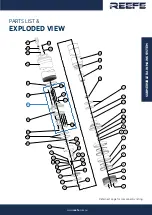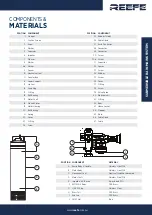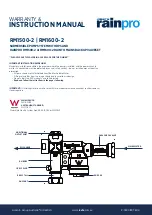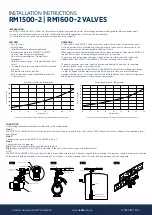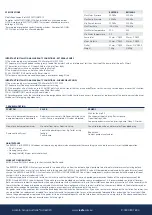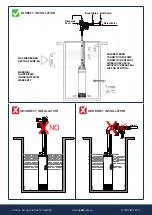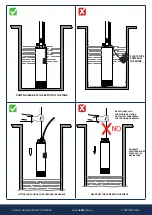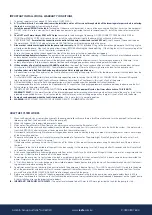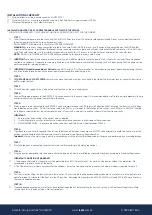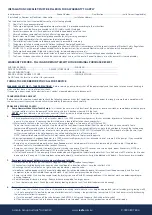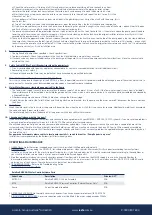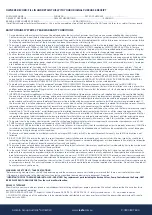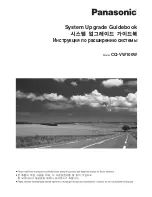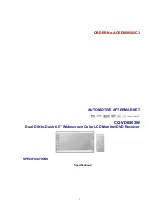
www.
reefe
.com.au
Ascento Group Australia
©
AI.062020
P: 1800 807 604
INSTALLATION CHECKLIST: MUST BE FILLED IN FOR A WARRANTY TO APPLY
Installer name:................................................................................Phone Number:............................................... Qualification:........................................(write Owner if applicable)
If installed by a Plumber or Electrician - Licence No: ..............................................Installation Address: ...................................................................................................................
Tick the boxes as the item is compelted/correct, put n/a if not applicable
☐
Steps 1 to 10 have been completed
☐
The Pump is being used for an appropriate purpose for which it is intended, according to the instructions
☐
The Power Circuit the Pump is connected to is RCD (Safety Switch) Protected
☐
A mozzie screen and/or first flush diverter is installed to keep debris out of the tank
☐
All swarf has been removed from the tank after cutting openings etc.
☐
Barrel Unions are fitted on the external pipe connection for easy servicing and repairs
☐
Pipe is sized appropriately for the application (diameter and length)
☐
The installation is constructed so the pump can be easily removed for servicing
☐
The pump is installed in accordance with National and Local Plumbing Regulations
☐
The Electrical Supply cable of the pump is plugged into a Power Outlet that is in accordance with the current standard of Electrical Safety Regulations
AS/NZS 3000 – or the pump has been wired directly to the power circuit by a Licenced Electrician, with an isolation switch incorporated.
☐
The Pump has been primed (filled with water) started, tested, and operates correctly.
☐
The pipes and connections and the barrel-union on the pump, and toilet cisterns (if connected) have been checked for leaks.
☐
The Owner has been shown how to check the tank water level, and re-set the pump (if owner/resident not in attendance this is not applicable.)
THINGS TO CHECK BEFORE YOU CALL FOR SERVICE
WARNING! SAFETY FIRST – TAKE PRECAUTIONS!
Before servicing a pump, always shut off the power supply and then make sure you are not standing in
water and that there is no risk of electrical shock.
If the pump is direct-wired to the electrical circuit, contact a licensed electrician to disconnect it.
TROUBLESHOOTING CHECKLIST
Before you call for service or repair, please check the following common issues that sometimes cause the owner to wrongly assume there is a problem with
the pump system. Unnecessary service calls must be paid by the owner, so check carefully.
PROBLEMS & POSSIBLE CAUSES:
1.
Pump Operates When Water Tank Is Empty:
this is either the normal re-start function of the pump, or due to an airlock, or some debris inside the pump
> simple solution is to turn the power off to the pump, and turn it back on when rain fills the tank.
NOTICE:
tank level indicators are not always accurate!! Check inside the tank to be sure of the water level.
2. Pump does not run or motor runs for a short time, then stops
i. Circuit breaker or Safety Switch is off or fuse has blown > in a SAFE manner investigate why this has occurred, by process of elimination > do not
assume it is the pump > if you cannot do this safely, have a licenced Electrician check and rectify it.
ii. Water level in the tank is too low > Top up or use alternative supply > or turn pump off until the tank fills
To be sure there is rainwater in the tank > tap the side of the tank, does it sound hollow? Feel the side of the tank, you can normally feel a
temperature difference from where the water is to where there is none. If you cannot tell that way, get a torch and look in through the tank opening.
The pump generally needs 250mm of water to work properly, pumps with FLOAT SWITCH will need 250 to 800mm depth of water. Be sure, if you
call for service and tank is found to be empty, you will be liable for the cost of the service call.
NOTE: Submersible Pumps with Float Switch may require up to 600mm of water level to operate.
iii. Electrical components have been flooded > in a SAFE manner investigate why this has occurred > do not assume it is the pump > if you cannot do
this safely, have a licenced Electrician check and rectify it.
iv. Pump plug is not connected properly, or has been flooded or wet > Isolate power at main switch, remove plug & allow to dry. If the problem
continues, contact a licenced electrician to check the cause.
v. Pump has an air-lock >Start and stop several times by turning the power off, wait 30 seconds, and turn on again, repeat if necessary. NOTE: you
might need to turn the Townwater supply OFF to make it easier to re-start the pump.
vi. If all of the above are OK, the pump might have overheated and triggered the thermal overload switch > Turn it off and wait 30 minutes for it to cool
down and turn it on again > If the pump does not operate normally, investigate why, it might be blocked with debris, > flush clean and re-assemble.
3. Pump runs but does not deliver water or only a small amount of water
i. Water filters on the discharge (if fitted) are clogged > check / clean /replace the cartridges
ii. Check valve is installed backwards, arrow on valve should point in direction of flow > have the installer fix this.
iii. Discharge shut-off valve/ball-valve / gate-valve may be closed > open the valve.
iv. Impeller or volute openings are fully or partially clogged or it might be blocked with debris > disconnect from the power supply, and if you are
competent to do so, disassemble the pump and clean. If not, have a pump technician do it for you.
v. Pump is air-locked > Start and stop several times by turning it on and off with 20 seconds between. If this does not work, see below regarding re-
priming the pump
vi. Vertical pumping distance is too high - Reduce distance or upgrade to a larger pump.
vii. Tank too low water level > Check the water level by looking inside the tank (Tank level indicators can be wrong)
4. Pump runs and does not stop or runs when no taps are in use – or cycles on/off/on/off continually
i. In most cases this situation it is due to a leak in pipework or leaking toilet cisterns or an underground pipe leak (wet soil, muddy, grass growing well!)
> it is not a pump fault > ascertain by process of elimination what is leaking > the quickest way to ascertain if it is in the house is usually by checking
the water meter, follow this process;
a) Turn the pump off, and turn off the valve between the RM1500-2 Valves and the pump (Ball-valve or Gate-valve)
b) Then ensure all water outlets in the house and garden etc are turned off, ensure that any garden taps are off and not dripping.
WARRANTY RECORD - FILL IN AND RETAIN THIS WITH YOUR ORIGINAL PURCHASE RECEIPT
PURCHASER NAME:.............................................................................................................PHONE NO.........................................................................
DATE OF PURCHASE.............../................./.............. DEALER/STORE NAME...........................................................................................................
DEALER SUBURB/TOWN...................................................................................................PHONE NO..........................................................................
BRAND & MODEL NUMBER OF PUMP............................................................................SERIAL/BATCH NO..........................................................
Do NOT send this form to us, retain it for your record.


